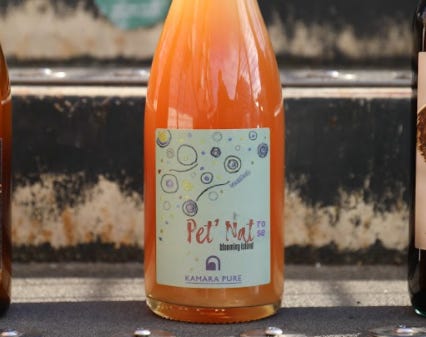What's a Pét-Nat?
What’s a refreshing, lightweight and delicately sparkling (most of the time) drink that ends with the word ‘nat’? That’s right. A pét-nat!
“Pét-nat. What is that?”
Well, the word ‘pét-nat’ we hear about on the likes of Instagram and F*ck That’s Delicious is just an abbreviation of the French word ‘pétillant naturel’ which simply translates to ‘natural sparkling’ in English. Pét-nat’s are unique in so many ways, a different type of sparkling wine compared to a Champagne for example. We’ll get into that one soon…
“It’s exciting to be part of a movement (the pét-nat scene) and it’s only just starting here in the UK” says Tim Wildman, British natural winemaker of Australian-produced pét-nat’s ‘Astro Bunny’ and ‘Piggy Pop’.
“Is Pét-Nat the same as natural wine?”
Yes. It is a wine that undergoes the same low-intervention process as any other natural wine would; organic or biodynamic red and white grapes, little to no human intervention and no human or wine harming additives.
The only difference between a still wine and a pét-nat is that pét-nat’s are bottled before the fermentation process has finished, you know? Whilst the sugars from the grapes and yeasts are still actively dancing. This process welcomes the arrival of carbon dioxide, which in-turn naturally creates those delicious bubbles in-bottle - an ancient method dating all the way back to the 1500s!
So the next time your mate asks for two glasses of the pét-nat when you're at your local wine bar, it’s up to you to piece together what you’re about to get. Either way, it’s definitely going to be natural and sparkling.
Why pét-nat’s are so trendy
It’s important to firstly recognise that although they are cool to be sipping on now, which i can definitely vouch for…pét-nats have been around for many many years. ‘Methode Ancestral’ they sometimes call them in France! I’d say that pét-nats are becoming so trendy at the moment because you don’t need to know much about natural wine to enjoy the concept of a pét-nat; it’s a simple, low-alcohol sparkling wine that comes available in a whole range of colours and flavours. That’s it.
Another reason these electric bottles of joy are so popular is down to the visual aspect. Pét-nat’s have it all - from their typically well-designed, tongue-in-cheek labels to their mouthwatering appearance thanks to the freedom of winemakers being able to produce pét-nats with whatever colour and type of grape they want.
Especially in such a visual-led society that we live in, those bright yellows, oranges, pinks and purples that you tend to see in a pét-nat have positive emotional connotations to us as humans.
“We might also like certain colours because of their emotional connotations. Yellow, for example, is often seen as a ‘happy’ colour”
The Difference between a Pét-Nat and a Champagne
Most people in the wine industry will tell you that ‘pét-nats are like a Champagnes younger cousin’ or along those lines, now whether you view that statement positively or negatively is subjective. I would say it is a positively fair assessment. The process it takes to produce a pét-nat is far less labour intensive, the ‘rules and regulations’ are a lot more relaxed and there are generally a lot less pretentious w$nkers involved in the pét-nat scene compared to the Champagne scene. In my opinion of course…
Traditionally, Champagne’s are produced by blending two or more wines that have already finished their fermentation, as well using external yeast and a sugary liqueur. All of those ingredients are combined together and then bottled so that they can age, during this ageing process the yeast eats up all the sugar from the liqueur and creates carbon dioxide which provides you the end drinker with that charming Champagne sparkle. So kinda similar to a pét-nat.
One of my favourite differences between a pét-nat and a champagne is a point I made just a couple paragraphs above regarding the element of freedom in the natural wine industry compared to the traditional wine industry. Natural winemakers who produce pét-nat’s have the licence to experiment and be free. They can use whatever colour grape variety they like! So yes, a pét-nat can be mellow yellow, or hazy orange in appearance!
Whereas with Champagne, there can be strict rules you must follow throughout the entire process such as geographical requirements and abiding to a short list of grape varieties you can actually work with to put the prestigious name ‘Champagne’ on the label.
Foods to pair with a ‘pét-nat’
Remember what we agreed on? Pét-nats are fun and fairly straight-forward, which means they can be paired with most types of foods and cuisines. Ideally go for the lighter dishes to match this elegant bubbly wine and you’ll be just fine.
What instantly springs to mind is a lush, fruit-forward rose pet-nat paired alongside mexican refried beans accompanied with a poached egg for those extrain protein gains of course.
Or a crisp, refreshing ‘white’ pét-nat like the Chenin Blanc ‘Fujisan Pét-Nat’ by Jauma Wines paired next to a deli-like bacon, egg and cheese sandwich. I'm telling you, these simplistic, yet compelling sparkling wines really can be paired with just about any dish you like. That freedom is the beauty of natural wine and is integral to universal appreciation as this movement grows.
“You can't separate peace from freedom because no one can be at peace unless he has his freedom.” Malcolm X
4 of my favourite pét-nat’s on the UK market right now
Ancre Hill, Pét-Nat Red (£18.00) - Vin de Bodega.
Jauma Wines, Fujisan Pét Nat (£28.00) - Juiced Wines.
Alex Della Vecchia, Grinton Movest (£21.00) - Oranj.
Anders Frederik Steen, I Hope Every Day (£35.00) - Wayward Wines.





